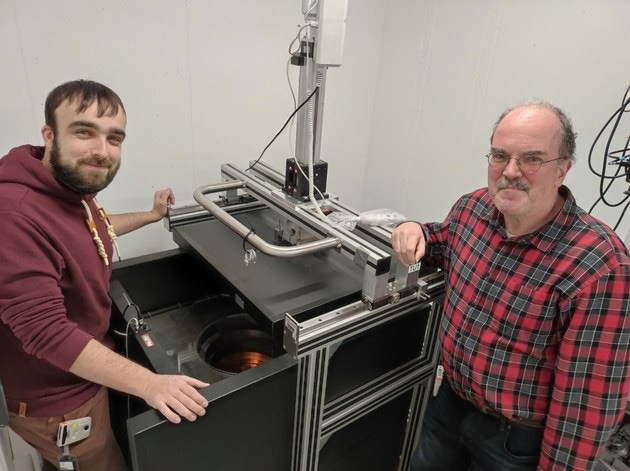Researchers have set out to answer questions about dark matter, neutrinos, the working of stars and what was going on in the universe during the first minutes following the Big Bang. However, a lot of skill and very sensitive detectors are required to find the answers.
 The “Felsenkeller” underground laboratory in Dresden now hosts the most sensitive setup for measuring radioactivity in Germany and one of the most sensitive setups in the world. With the new detector, researchers at the Technische Universität Dresden and the Helmholtz-Zentrum Dresden-Rossendorf (HZDR) will in future be working at the highest international level on some of the most exciting questions in astrophysics, such as dark matter, stars, or the Big Bang. Image Credit: Technische Universitat Dresden.
The “Felsenkeller” underground laboratory in Dresden now hosts the most sensitive setup for measuring radioactivity in Germany and one of the most sensitive setups in the world. With the new detector, researchers at the Technische Universität Dresden and the Helmholtz-Zentrum Dresden-Rossendorf (HZDR) will in future be working at the highest international level on some of the most exciting questions in astrophysics, such as dark matter, stars, or the Big Bang. Image Credit: Technische Universitat Dresden.
Across the globe, just a few laboratories have been able to execute such sensitive measurements - until now. An ultra-sensitive detector has been established in Germany, which will allow scientists to find answers to such questions in the future.
Following long development work, scientists from the Institute for Nuclear and Particle Physics (Technische Universität Dresden) and the Institute for Radiation Physics (HZDR) have currently put the setup into action in the underground laboratory “Felsenkeller” Dresden.
In the future, the researchers will be able to examine samples of materials and substances with radioactivity in the range of 100 microbequerels. For context, samples with this level of radioactivity have 100 million times less radioactivity than that in the human body, making the measurement setup in the Felsenkeller laboratory one of the world's most sensitive measuring instruments for radioactivity.
If you want to study rare processes and low activities in physics, you basically need two things: on the one hand, a lot of patience - because the processes rarely take place - and on the other hand, an environment that is as low in radiation as possible so that the detector is not permanently disturbed by natural sources of radiation.
Steffen Turkat, Staff Member, Felsenkeller Laboratory, Technische Universitat Dresden
Accordingly, the 45-m-thick rock overburden in the tunnel of the former ice storage facility of the Dresden Felsenkeller brewery safeguards the detector from the majority of the cosmic radiation, but not from natural radioactivity from the surrounding.
Hence, the scientists had to safeguard the detector with an advanced setup depending on low-radiation concrete walls, vast amounts of copper and lead, and alleged veto detectors. This is the only way this very sensitive setup could function and assess nuclear transitions from useful samples.
I am particularly pleased about the large number of unplanned inquiries from interested colleagues worldwide who would now like to use the detector. These requests quickly involve extremely valuable and rare samples that are scientifically very exciting but which cannot be analyzed with other detectors. A detector like this automatically generates new collaborations and networks with other fascinating fields.
Steffen Turkat, Staff Member, Felsenkeller Laboratory, Technische Universitat Dresden
Prof. Kai Zuber of Technische Universität Dresden is the scientific director of the Felsenkeller laboratory and is especially anticipating being able to follow his own difficult research interests in physics beyond the Standard Model: “I am particularly interested in double beta decay and the search for charged lepton violation. Furthermore, my focus lies on the study of the half-lives of radionuclides. The new detector at Felsenkeller is excellently suited for that.”
We can now perform activation measurements for nuclear fusion experiments at energies much closer to the actual energies and temperatures in our Sun than was previously possible. This also creates a new synergy for the Felsenkeller accelerator.
Daniel Bemmerer, Technical Director, Felsenkeller Laboratory and Group Leader for Nuclear Astrophysics, Helmholtz-Zentrum Dresden-Rossendorf
Also, Bemmerer is excited about the new possibilities offered by the detector.
Besides the new detector, Germany's deepest underground physics laboratory already consists of an ion accelerator in operation since 2019 to learn about the most significant processes inside stars.
Journal Reference:
Turkat, S., et al. (2023) A new ultra low-level HPGe activity counting setup in the Felsenkeller shallow-underground laboratory. Astroparticle Physics. doi.org/10.1016/j.astropartphys.2023.102816.